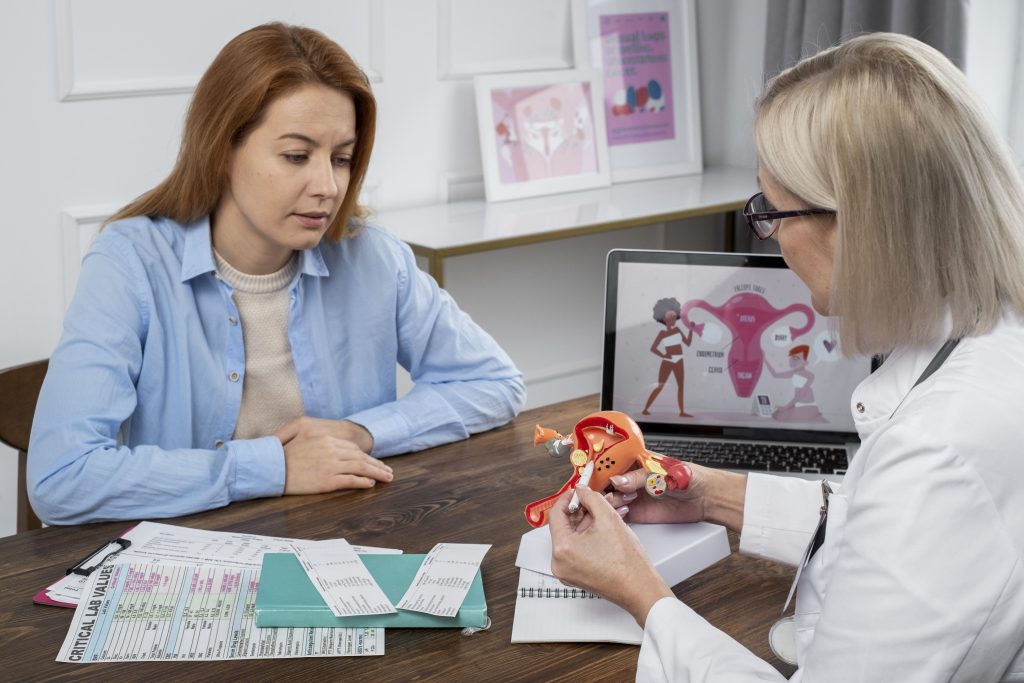What are the symptoms?
The symptoms of endometriosis can vary from person to person. Some women may have mild or no symptoms, while others may experience severe pain and other problems. The most common symptoms include:
- Pelvic pain
- Painful periods
- Painful intercourse
- Heavy bleeding between periods
- Spotting between periods
- Long or irregular periods
- Fertility problems
- Other symptoms, such as fatigue, nausea, vomiting, diarrhea, and constipation
What Risk factors can increase the likelihood of developing endometriosis?
Certain factors can increase the risk of developing endometriosis, including family history of the condition, early onset of menstruation, frequent and heavy periods, and not having given birth. Other factors that may increase the risk of endometriosis include exposure to toxins and chemicals, such as dioxin, and having a low body mass index (BMI). For example, studies have shown that women who have a history of pelvic infections or reproductive tract abnormalities may be at increased risk for the condition. Additionally, women who have a weakened immune system, such as those with autoimmune disorders or HIV, may be more susceptible to endometriosis.
Age is also a factor that can affect the risk of developing endometriosis. The condition is most diagnosed in women in their 30s and 40s, but it can occur at any age. Women who experience menopause at an older age may also be at increased risk of developing endometriosis. Hormonal factors may also play a role in the development of endometriosis.
Women with high levels of estrogen, a hormone that stimulates the growth of the uterine lining, may be at increased risk of developing the condition. This may be why endometriosis is more commonly found in women during their reproductive years, when estrogen levels are highest. In addition to these risk factors, certain lifestyle factors may also increase the risk of endometriosis. For example, women who smoke are more likely to develop the condition, as smoking can impair the immune system and increase inflammation in the body. Additionally, women who consume high levels of caffeine or alcohol may also be at increased risk of developing endometriosis.
How is endometriosis diagnosed?
There is no single test to diagnose endometriosis. Doctors typically use a combination of methods, including:
- Pelvic exam: A pelvic exam can help doctors to feel for any abnormalities in the pelvic organs.
- Imaging tests: Imaging tests such as ultrasound and MRI can be used to create images of the pelvic organs. This can help doctors to identify any endometriotic lesions.
- Laparoscopy: Laparoscopy is a surgical procedure that allows doctors to view the pelvic organs directly. This is the gold standard test for diagnosing endometriosis.
How is endometriosis treated?
There is no cure for endometriosis, but there are a variety of treatments that can help to manage the symptoms and improve the quality of life. Treatment options include:
Pain medication: Over-the-counter pain medications such as ibuprofen and acetaminophen can be used to relieve mild to moderate pain. Prescription pain medications may be needed for more severe pain.
Hormonal therapy: Hormonal therapy can be used to suppress the growth of endometrial tissue and reduce pain. Hormonal therapy options include birth control pills, progestin-only birth control, and gonadotropin-releasing hormone (GnRH) agonists.
Surgery: Surgery may be recommended for women with severe endometriosis or who have not responded to other treatments. Surgery can be used to remove endometriotic lesions or the entire uterus and ovaries.
Why choose Ultram Private Ultrasound?
At Ultram Private Ultrasound, we offer a comprehensive diagnostic service for endometriosis. We use the latest ultrasound technology to accurately diagnose endometriosis and provide patients with the information and support they need to manage their condition. Our team of experienced professionals provides patients with the highest quality of care and service. We understand that dealing with a medical condition can be stressful and overwhelming. We strive to provide a comfortable and supportive environment for our patients. If you are experiencing symptoms of endometriosis, please contact Ultram Private Ultrasound to schedule an appointment.

